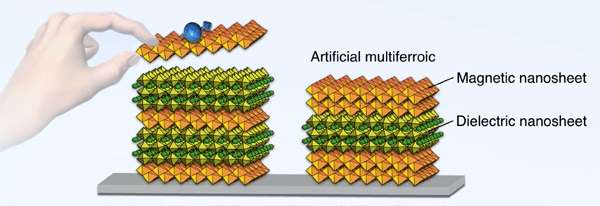New multiferroic materials from building blocks

A research group in Japan successfully developed room temperature multiferroic materials by a layer-by-layer assembly of nanosheet building blocks. Multiferroic materials are expected to play a vital role in the development of next-generation multifunctional electronic devices.
A research group led by principal investigator Minoru Osada and fellow Takayoshi Sasaki, International Center for Materials Nanoarchitectonics (MANA), National Institute for Materials Science (NIMS), successfully developed room temperature multiferroic materials by a layer-by-layer assembly of nanosheet building blocks. Multiferroic materials are expected to play a vital role in the development of next-generation multifunctional electronic devices.
The design of new multiferroics, or materials that display both ferroelectricity and ferromagnetism, is of fundamental importance for new electronic technologies. However, the co-existence of ferroelectricity and magnetic order at room temperature in single compounds is rare, and heterostructures with such multiferroic properties have only been made with complex techniques (such as pulsed-laser deposition and molecular beam epitaxy).
Seeking to develop room-temperature multiferroics, the research group utilized a new chemical design for artificial multiferroic thin films using two-dimensional oxide nanosheets as building blocks (Figure 1). This approach enables engineering the interlayer coupling between the ferromagnetic and ferroelectric orders, as demonstrated by artificial superlattices composed of ferromagnetic Ti0.8Co0.2O2 nanosheets and dielectric perovskite-structured Ca2Nb3O10 nanosheets. The (Ti0.8Co0.2O2/Ca2Nb3O10/Ti0.8Co0.2O2) superlattices exhibit the multiferroic effects at room temperature, which can be modulated by tuning the interlayer coupling (i.e., the stacking sequence).
This study opens a pathway to create new artificial materials with tailored multiferroic properties. In addition, the successful development of room temperature multiferroic nanofilms may lead to their application to new memory devices, taking advantage of their multifunctionality and low-voltage operation. This study was published in the online version of the Journal of the American Chemical Society on June 13, 2016.
More information: Bao-Wen Li et al. Coexistence of Magnetic Order and Ferroelectricity at 2D Nanosheet Interfaces, Journal of the American Chemical Society (2016). DOI: 10.1021/jacs.6b02722
Journal information: Journal of the American Chemical Society
Provided by National Institute for Materials Science



















